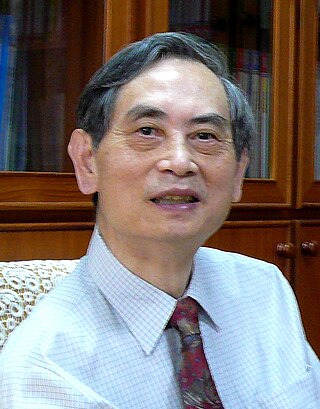Related Research Articles

Spectroscopy is the field of study that measures and interprets the electromagnetic spectra that result from the interaction between electromagnetic radiation and matter as a function of the wavelength or frequency of the radiation. Matter waves and acoustic waves can also be considered forms of radiative energy, and recently gravitational waves have been associated with a spectral signature in the context of the Laser Interferometer Gravitational-Wave Observatory (LIGO).

Scattering is a term used in physics to describe a wide range of physical processes where moving particles or radiation of some form, such as light or sound, are forced to deviate from a straight trajectory by localized non-uniformities in the medium through which they pass. In conventional use, this also includes deviation of reflected radiation from the angle predicted by the law of reflection. Reflections of radiation that undergo scattering are often called diffuse reflections and unscattered reflections are called specular (mirror-like) reflections. Originally, the term was confined to light scattering. As more "ray"-like phenomena were discovered, the idea of scattering was extended to them, so that William Herschel could refer to the scattering of "heat rays" in 1800. John Tyndall, a pioneer in light scattering research, noted the connection between light scattering and acoustic scattering in the 1870s. Near the end of the 19th century, the scattering of cathode rays and X-rays was observed and discussed. With the discovery of subatomic particles and the development of quantum theory in the 20th century, the sense of the term became broader as it was recognized that the same mathematical frameworks used in light scattering could be applied to many other phenomena.

Neutron diffraction or elastic neutron scattering is the application of neutron scattering to the determination of the atomic and/or magnetic structure of a material. A sample to be examined is placed in a beam of thermal or cold neutrons to obtain a diffraction pattern that provides information of the structure of the material. The technique is similar to X-ray diffraction but due to their different scattering properties, neutrons and X-rays provide complementary information: X-Rays are suited for superficial analysis, strong x-rays from synchrotron radiation are suited for shallow depths or thin specimens, while neutrons having high penetration depth are suited for bulk samples.

Neutron scattering, the irregular dispersal of free neutrons by matter, can refer to either the naturally occurring physical process itself or to the man-made experimental techniques that use the natural process for investigating materials. The natural/physical phenomenon is of elemental importance in nuclear engineering and the nuclear sciences. Regarding the experimental technique, understanding and manipulating neutron scattering is fundamental to the applications used in crystallography, physics, physical chemistry, biophysics, and materials research.
In chemistry, nuclear physics, and particle physics, inelastic scattering is a fundamental scattering process in which the kinetic energy of an incident particle is not conserved. In an inelastic scattering process, some of the energy of the incident particle is lost or increased. Although the term is historically related to the concept of inelastic collision in dynamics, the two concepts are quite distinct; inelastic collision in dynamics refers to processes in which the total macroscopic kinetic energy is not conserved. In general, scattering due to inelastic collisions will be inelastic, but, since elastic collisions often transfer kinetic energy between particles, scattering due to elastic collisions can also be inelastic, as in Compton scattering meaning the two particles in the collision transfer energy causing a loss of energy in one particle.
The λ (lambda) universality class is a group in condensed matter physics. It regroups several systems possessing strong analogies, namely, superfluids, superconductors and smectics. All these systems are expected to belong to the same universality class for the thermodynamic critical properties of the phase transition. While these systems are quite different at the first glance, they all are described by similar formalisms and their typical phase diagrams are identical.

Neutron detection is the effective detection of neutrons entering a well-positioned detector. There are two key aspects to effective neutron detection: hardware and software. Detection hardware refers to the kind of neutron detector used and to the electronics used in the detection setup. Further, the hardware setup also defines key experimental parameters, such as source-detector distance, solid angle and detector shielding. Detection software consists of analysis tools that perform tasks such as graphical analysis to measure the number and energies of neutrons striking the detector.

The Mainz Microtron, abbreviated MAMI, is a microtron which provides a continuous wave, high intensity, polarized electron beam with an energy up to 1.6 GeV. MAMI is the core of an experimental facility for particle, nuclear and X-ray radiation physics at the Johannes Gutenberg University in Mainz (Germany). It is one of the largest campus-based accelerator facilities for basic research in Europe. The experiments at MAMI are performed by about 200 physicists of many countries organized in international collaborations.

Neutron spin echo spectroscopy is an inelastic neutron scattering technique invented by Ferenc Mezei in the 1970s, and developed in collaboration with John Hayter. In recognition of his work and in other areas, Mezei was awarded the first Walter Haelg Prize in 1999.

Léon Charles Prudent Van Hove was a Belgian physicist and a Director General of CERN. He developed a scientific career spanning mathematics, solid state physics, elementary particle and nuclear physics to cosmology.

In physics, the atomic form factor, or atomic scattering factor, is a measure of the scattering amplitude of a wave by an isolated atom. The atomic form factor depends on the type of scattering, which in turn depends on the nature of the incident radiation, typically X-ray, electron or neutron. The common feature of all form factors is that they involve a Fourier transform of a spatial density distribution of the scattering object from real space to momentum space. For an object with spatial density distribution, , the form factor, , is defined as
Helium atom scattering (HAS) is a surface analysis technique used in materials science. HAS provides information about the surface structure and lattice dynamics of a material by measuring the diffracted atoms from a monochromatic helium beam incident on the sample.
Jump diffusion is a stochastic process that involves jumps and diffusion. It has important applications in magnetic reconnection, coronal mass ejections, condensed matter physics, option pricing, and pattern theory and computational vision.

Resonant inelastic X-ray scattering (RIXS) is an X-ray spectroscopy technique used to investigate the electronic structure of molecules and materials.
Neutron scattering is a spectroscopic method of measuring the atomic and magnetic motions of atoms. Inelastic neutron scattering observes the change in the energy of the neutron as it scatters from a sample and can be used to probe a wide variety of different physical phenomena such as the motions of atoms, the rotational modes of molecules, sound modes and molecular vibrations, recoil in quantum fluids, magnetic and quantum excitations or even electronic transitions. Since its discovery, neutron spectroscopy has also become useful in medicine as it has been applied to radiation protection and radiation therapy. Although neutron spectroscopy is capable of operating on many orders of magnitude of electron volts, current and recent research has focused on expanding neutron scattering to higher energy levels.
In physics, quasielastic scattering designates a limiting case of inelastic scattering, characterized by energy transfers being small compared to the incident energy of the scattered particles.

Sow-Hsin Chen, was a Hoklo Taiwanese physicist and Professor Emeritus at Massachusetts Institute of Technology (MIT). He was a recognized pioneer in the research of the dynamic properties of supercooled and interfacial water with the use of neutron scattering techniques. As an educator, he was recognized for his training of young scientists in the use of those same techniques. Regarding hydrogen storage, his research focused on the use of activated carbon to allow hydrogen to be stored at room temperature.

Magda Galula Ericson (born 1929) is a French-Algerian physicist of Tunisian origin. Her experimental pioneering PhD work changed the understanding of critical phenomena near the Curie point and later in her career she has become known for her theoretical development of the Ericson-Ericson Lorentz-Lorenz correction.
Helium-3 surface spin echo (HeSE) is an inelastic scattering technique in surface science that has been used to measure microscopic dynamics at well-defined surfaces in ultra-high vacuum. The information available from HeSE complements and extends that available from other inelastic scattering techniques such as neutron spin echo and traditional helium-4 atom scattering (HAS).
References
- ↑ Van Hove, L.; McVoy, K.W. (1962). "Pair distribution functions and scattering phenomena". Nuclear Physics. Elsevier BV. 33: 468–476. doi:10.1016/0029-5582(62)90539-4. ISSN 0029-5582.
- ↑ de Gennes, P.G. (1963). "Collective motions of hydrogen bonds". Solid State Communications. Elsevier BV. 1 (6): 132–137. doi:10.1016/0038-1098(63)90212-6. ISSN 0038-1098.